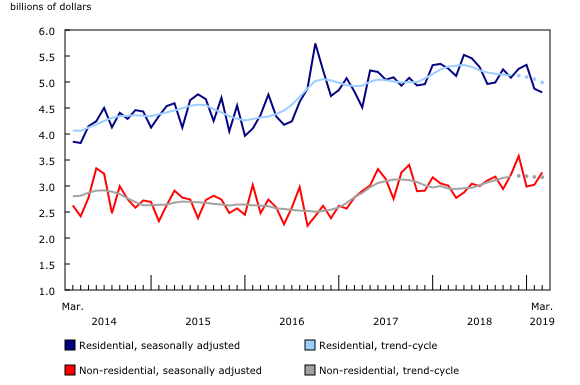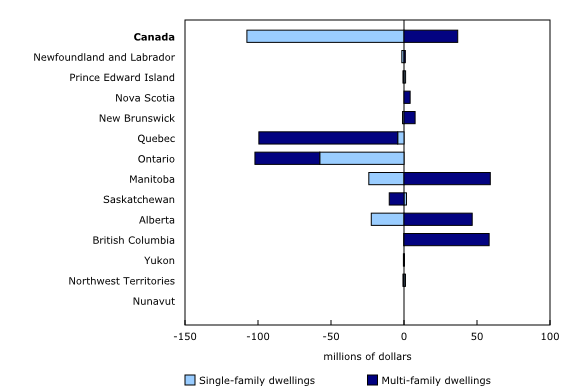Building permits, March 2019
Archived Content
Information identified as archived is provided for reference, research or recordkeeping purposes. It is not subject to the Government of Canada Web Standards and has not been altered or updated since it was archived. Please "contact us" to request a format other than those available.
Released: 2019-05-10
$8.1 billion
March 2019
2.1% 
(monthly change)
$38.2 million
March 2019
-30.0% 
(monthly change)
$20.8 million
March 2019
-16.5% 
(monthly change)
$116.2 million
March 2019
-1.4% 
(monthly change)
$83.4 million
March 2019
-6.4% 
(monthly change)
$1,704.2 million
March 2019
-0.8% 
(monthly change)
$3,103.1 million
March 2019
-1.4% 
(monthly change)
$292.3 million
March 2019
29.6% 
(monthly change)
$138.8 million
March 2019
27.8% 
(monthly change)
$940.4 million
March 2019
5.7% 
(monthly change)
$1,583.6 million
March 2019
12.8% 
(monthly change)
$5.2 million
March 2019
-70.1% 
(monthly change)
$2.1 million
March 2019
20.8% 
(monthly change)
F
March 2019
F
(monthly change)
Canadian municipalities issued $8.1 billion worth of building permits in March, up 2.1% from February. The increase was attributable to higher construction intentions in Western Canada.
Building permits up in Western Canada, down east of Manitoba
Four provinces reported increases in March, led by British Columbia with an increase of 12.8% (+$180 million). Meanwhile, all provinces east of Manitoba reported declines. The largest decrease was in Ontario, down 1.4% (-$43 million) due to lower construction intentions in the residential sector.
Quebec drives movement in non-residential permits
The national value of permits for non-residential buildings rose 7.9% in March, due to higher construction intentions for both institutional (+$175 million) and commercial (+$166 million) buildings. Gains in both of these components stemmed from Quebec. A high value permit for an addition to the Centre hospitalier de l'Université de Montréal drove the increase in the institutional component.
In the industrial component, the value of permits declined 15.6% in March (-$102 million). The decrease was largely the result of lower construction intentions in Quebec, where multiple high-value permits were issued in February.
The value of single-family permits declines in the residential sector
Municipalities issued $4.8 billion worth of residential permits in March, down 1.5% from February. The decline was largely attributable to lower construction intentions in Ontario (-$102 million) and Quebec (-$99 million).
The value of single-family dwelling permits was down 5.0% (-$108 million) from the previous month. Seven provinces reported declines, with the largest decrease in Ontario (-$58 million).
Meanwhile, the value of multi-family dwelling permits increased 1.3% (+$37 million) in March. Six provinces posted increases, led by Manitoba and British Columbia.
First quarter 2019: Permits down sharply in Alberta year over year
Municipalities issued $24.3 billion worth of permits in the first quarter, down 3.5% (-$877 million) compared with the same quarter last year. Five provinces posted declines, with the majority of the decrease coming from Alberta (-$1.0 billion).
Every component was down in Alberta in the first quarter compared with the same quarter last year. Single-family construction accounted for approximately half of the provincial decline (-$539 million). This was the lowest value for single-family dwelling permits since the first quarter of 2009.
Meanwhile, in Quebec, the value of permits rose 2.1% (+$105 million) year over year in the first quarter. Every component except multi-family dwellings was up. The increase was largely the result of higher construction intentions for non-residential buildings.
Note to readers
Unless otherwise stated, this release presents seasonally adjusted data, which facilitate month-to-month comparisons by removing the effects of seasonal variations. For information on seasonal adjustment, see Seasonally adjusted data – Frequently asked questions.
The Building Permits Survey covers over 2,400 municipalities, representing 95% of the Canadian population. The communities representing the other 5% of the population are very small and their levels of building activity have little impact on the total for the entire population.
Building permits data are used as a leading indicator of activity in the construction industry.
The value of planned construction activities presented in this release excludes engineering projects (such as waterworks, sewers or culverts) and land.
For the purposes of this release, the census metropolitan area of Ottawa–Gatineau (Ontario/Quebec) is divided into two areas: the Ottawa part and the Gatineau part.
Unless otherwise specified, the highlights refer to seasonally adjusted current dollars and are ranked in terms of dollar change rather than percentage change.
Building components
Single-family dwellings: Residential buildings containing only one dwelling unit (for example, single-detached house, bungalow, linked home [linked at the foundation]).
Multi-family dwellings: Residential buildings containing multiple dwelling units (for example, apartment, apartment condominium, row house, semi-detached).
Industrial buildings: Buildings used in the transformation or production of goods, or related to transportation and communication.
Commercial buildings: Buildings used in trade or distribution of goods and services.
Institutional and government buildings: Buildings used to house public and semi-public services such as those related to health and welfare, education, or public administration, as well as buildings used for religious services.
Revision
Unadjusted data for the current reference month are subject to revision based on late responses. Data for the previous month have been revised. Seasonally adjusted data are revised for the previous two months.
Trend-cycle estimates have been added to the charts as a complement to the seasonally adjusted series. Both seasonally adjusted data and trend-cycle estimates are subject to revision as additional observations become available. These revisions could be large and even lead to a reversal of movement, especially at the end of the series. The higher variability associated with trend-cycle estimates is indicated with a dotted line on the chart.
For information on trend-cycle data, see the StatCan Blog and Trend-cycle estimates – Frequently asked questions.
Next release
Data on building permits for April will be released on June 10.
Products
Statistics Canada has a new Housing Market Indicators Dashboard. This web application provides access to key housing market indicators for Canada, by province and by census metropolitan area. These indicators are automatically updated with new information from monthly releases, giving users access to the latest data.
Contact information
For more information, or to enquire about the concepts, methods or data quality of this release, contact us (toll-free 1-800-263-1136; 514-283-8300; STATCAN.infostats-infostats.STATCAN@canada.ca) or Media Relations (613-951-4636; STATCAN.mediahotline-ligneinfomedias.STATCAN@canada.ca).
- Date modified:





